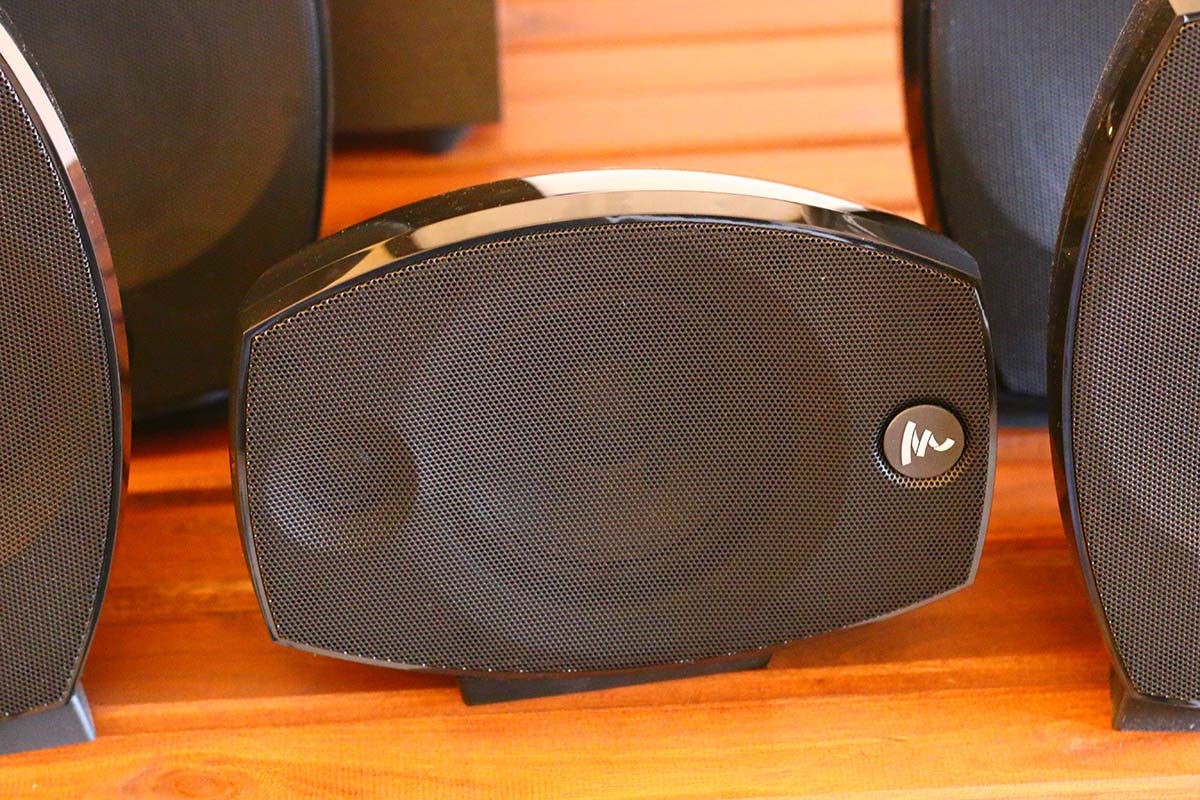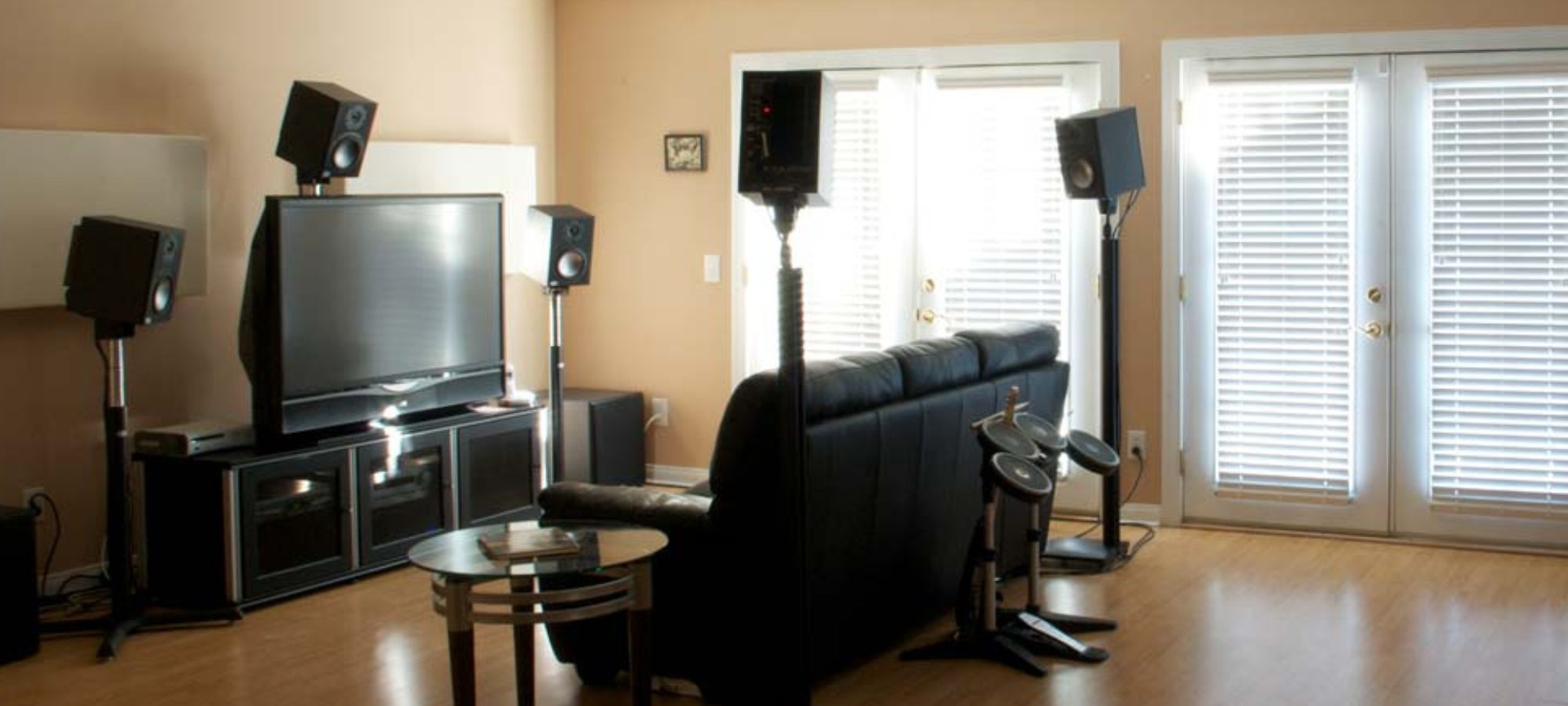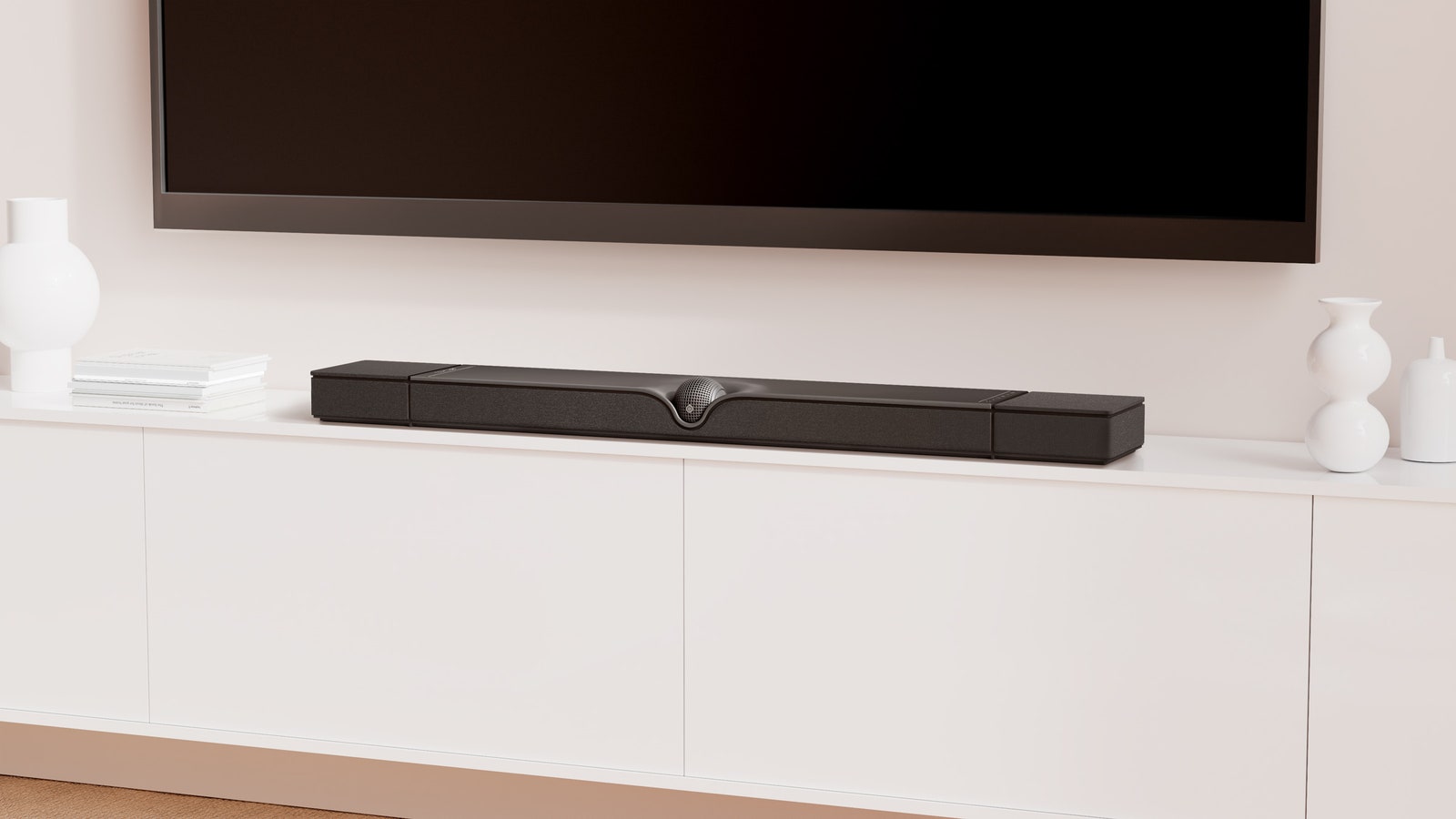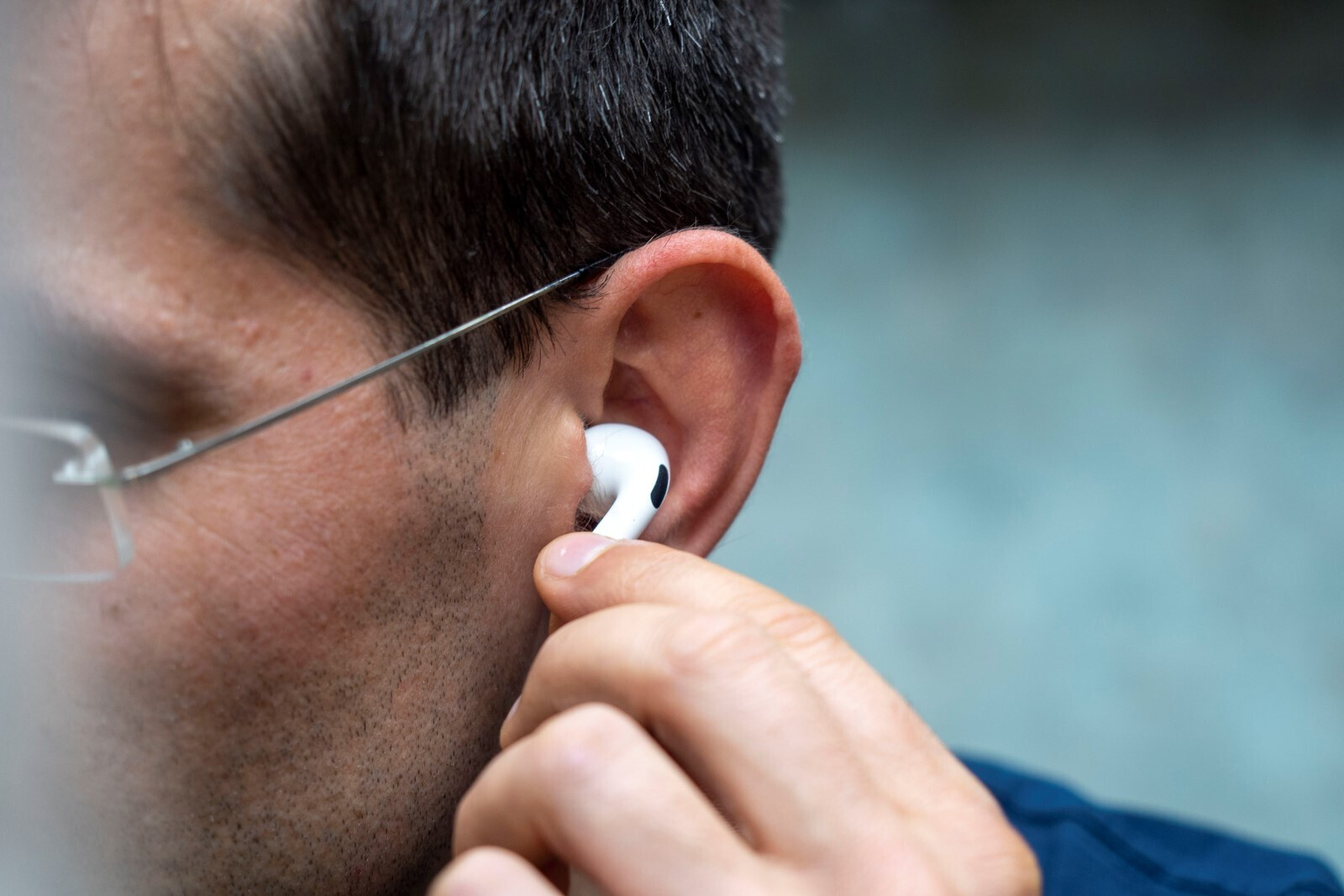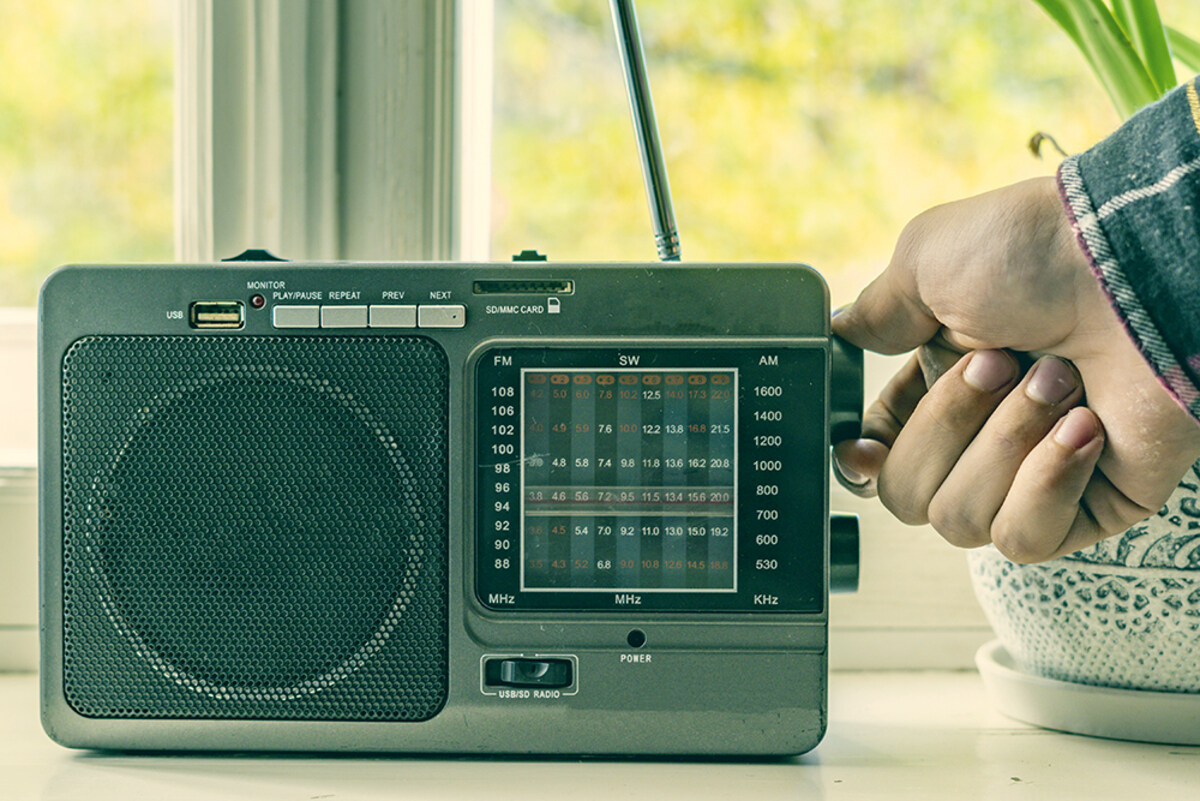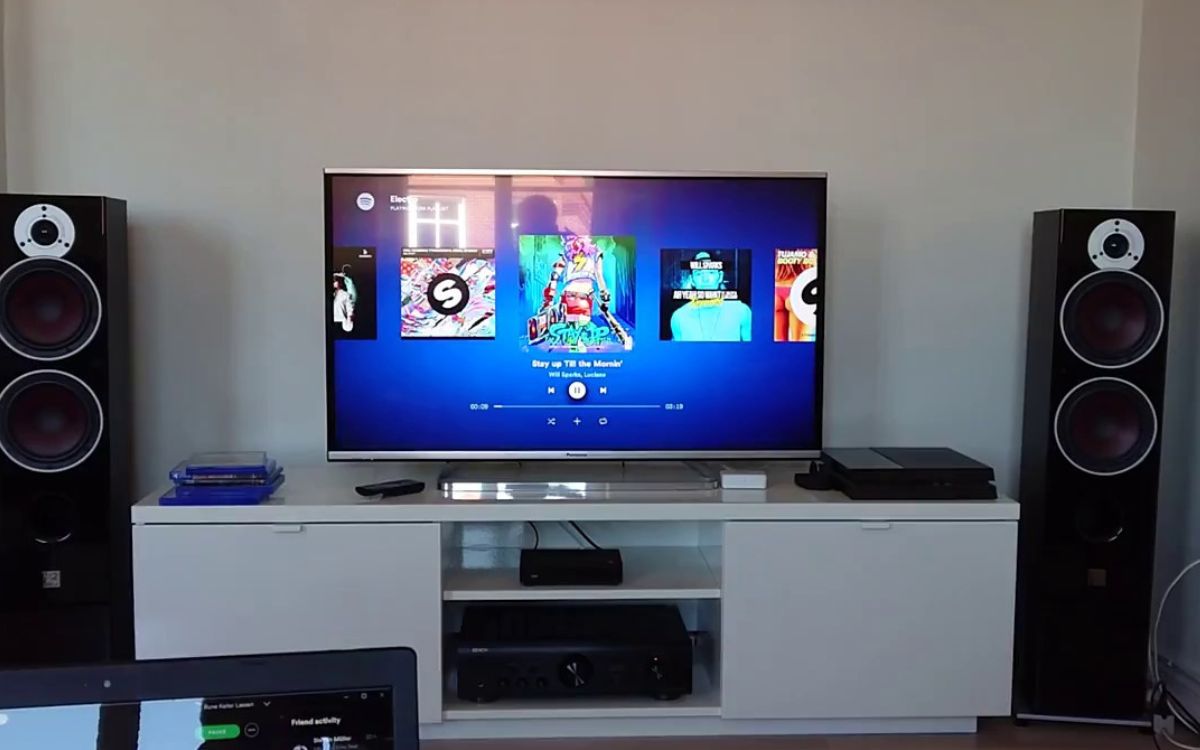Home>Production & Technology>Surround Sound>Why Is My Surround Sound Crackling
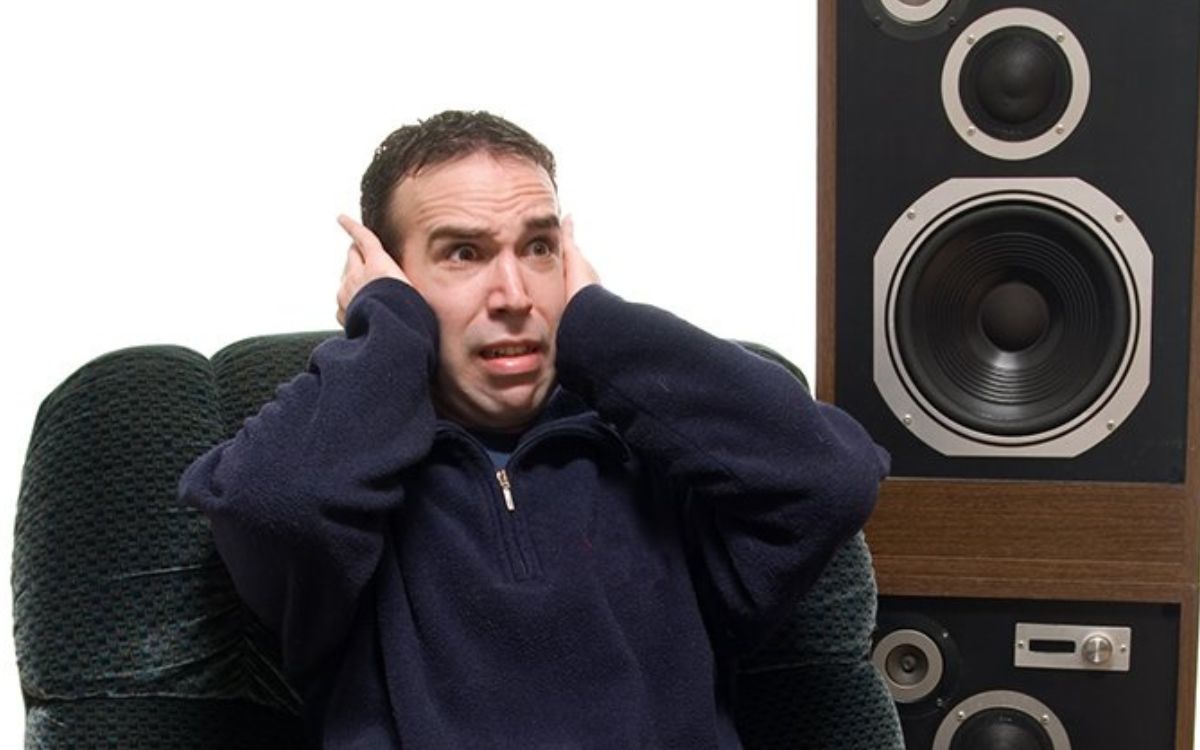

Surround Sound
Why Is My Surround Sound Crackling
Modified: January 22, 2024
Discover why your surround sound is crackling and learn how to fix it. Find solutions and troubleshooting tips for your surround sound system.
(Many of the links in this article redirect to a specific reviewed product. Your purchase of these products through affiliate links helps to generate commission for AudioLover.com, at no extra cost. Learn more)
Table of Contents
- Introduction
- Common Causes of Surround Sound Crackling
- Loose or Damaged Audio Cables
- Interference from Electronic Devices
- Speaker Placement and Wiring Issues
- Audio Receiver Problems
- Outdated or Faulty Surround Sound System Firmware
- Troubleshooting Steps to Fix Crackling in Surround Sound
- Check and Secure Audio Cables
- Minimize Electronic Interference
- Arrange Speakers Properly and Check Wiring
- Update Audio Receiver Firmware
- Contact Customer Support or Professional Assistance
- Conclusion
Introduction
Surround sound systems have revolutionized the way we experience audio in our homes. Whether you’re watching a movie, playing video games, or listening to music, a high-quality surround sound setup can provide an immersive and captivating audio experience. However, even the best systems can sometimes encounter issues, and one common problem that users often encounter is crackling sound.
Crackling sound in a surround sound system can be not only annoying but also disruptive to your entertainment experience. It can distort the audio, make dialogue difficult to understand, and ruin the overall enjoyment. But what causes this crackling sound, and how can you fix it?
In this article, we will explore the common causes of crackling sound in surround sound systems and provide troubleshooting steps to help you address the issue. From loose cables to speaker placement and firmware problems, we’ll cover a range of potential culprits and their solutions. Whether you have a home theater system or a multi-room audio setup, these tips will help you get rid of that irritating crackling sound and restore the pristine audio quality you deserve.
Before we dive into the solutions, it’s important to note that crackling sound can occur in both wired and wireless surround sound systems. While the specific causes and troubleshooting steps may vary slightly depending on your setup, the underlying principles and solutions discussed here can be applied to most surround sound systems.
Common Causes of Surround Sound Crackling
When faced with crackling sound in your surround sound system, it’s important to identify the underlying cause before attempting to fix it. Here are some of the common culprits behind crackling sound:
- Loose or Damaged Audio Cables: One of the primary causes of crackling sound is loose or damaged audio cables. If the cables connecting your speakers, receiver, or other audio devices are not securely plugged in or if they are worn out or frayed, it can lead to intermittent crackling sounds.
- Interference from Electronic Devices: Electronics such as smartphones, routers, microwave ovens, or even fluorescent lights can emit electromagnetic interference (EMI) or radio frequency interference (RFI) that can disrupt the audio signal and cause crackling sounds.
- Speaker Placement and Wiring Issues: Incorrect speaker placement or faulty wiring can also contribute to crackling sound. If the speakers are too close to each other or placed in inappropriate locations, sound waves can interfere with each other, resulting in crackling or buzzing noises.
- Audio Receiver Problems: A malfunctioning or outdated audio receiver can be another common cause of crackling sound. Issues with the receiver’s internal components, such as a faulty amplifier or outdated firmware, can lead to audio anomalies.
- Outdated or Faulty Surround Sound System Firmware: Just like any other electronic device, surround sound systems require regular updates to their firmware to ensure optimal performance. If your system’s firmware is outdated or if there are glitches in the software, it can cause various audio issues, including crackling sound.
Identifying the specific cause of crackling sound in your surround sound system requires careful observation and troubleshooting. By examining these common causes and taking the appropriate steps, you can effectively resolve the issue and enjoy crystal-clear audio once again.
Loose or Damaged Audio Cables
One of the primary causes of crackling sound in a surround sound system is loose or damaged audio cables. Over time, cables can become loose due to repeated movement or accidental bumps. Additionally, cables can deteriorate with age, resulting in poor audio quality.
To troubleshoot this issue, start by checking all the audio cables connected to your surround sound system. Make sure they are securely plugged into the appropriate ports on both the speakers and the audio receiver. Give each cable a gentle tug to ensure a snug fit.
If you notice any frayed or damaged cables, you should replace them immediately. Damaged cables can interfere with the audio signal and cause crackling sound. Look for any signs of wear and tear, such as exposed wires or damaged connectors.
It’s also important to consider the quality of the cables you are using. Poor quality or outdated cables may not provide sufficient shielding, leading to interference and crackling sound. Investing in high-quality, shielded cables can significantly reduce the chances of audio issues occurring.
Furthermore, pay attention to the length of the cables. Excessively long cables can negatively impact the audio signal, leading to signal loss or degradation. If possible, use the shortest possible cables that still allow for proper speaker placement and connectivity.
Regularly inspecting and maintaining your audio cables is essential to ensure optimal audio performance. By taking the time to secure and replace any loose or damaged cables, you can eliminate crackling sound and enjoy a seamless surround sound experience.
Interference from Electronic Devices
Electronic devices, such as smartphones, routers, microwave ovens, and even fluorescent lights, can emit electromagnetic interference (EMI) or radio frequency interference (RFI) that can negatively impact the audio signal in a surround sound system. This interference can result in crackling or buzzing sounds.
To minimize interference from electronic devices, there are several steps you can take:
- Keep electronic devices away from your surround sound system: Try to position your audio receiver and speakers away from other electronic devices. The closer they are, the higher the chances of interference. Keep them at a distance of at least a few feet to reduce the risk of EMI or RFI affecting your audio signal.
- Use shielded cables: Shielded audio cables are designed to protect against electromagnetic interference. Using shielded cables for all audio connections can help minimize the impact of external electronic interference and reduce crackling sounds.
- Disable wireless devices: Wi-Fi routers, cordless phones, and other wireless devices can generate interference. If you notice crackling sound in your surround sound system, try turning off nearby wireless devices to see if it improves the audio quality. Alternatively, you can change the channel frequency of your Wi-Fi router to mitigate interference.
- Isolate power sources: Connect your audio receiver and speakers to a separate power outlet or power strip to reduce the chances of electrical interference. Avoid using the same power source as other high-power devices, as they can introduce noise into the electrical circuit.
By being mindful of the presence and placement of other electronic devices, using shielded cables, and isolating power sources, you can minimize the interference that can lead to crackling sounds in your surround sound system. These simple steps can go a long way in ensuring clear and uninterrupted audio playback.
Speaker Placement and Wiring Issues
Incorrect speaker placement or faulty wiring can also contribute to crackling sound in a surround sound system. If the speakers are not positioned properly or if there are issues with the wiring, it can result in distorted audio and undesirable crackling noises.
Here are some steps you can take to address speaker placement and wiring issues:
- Check speaker positioning: Ensure that your surround sound speakers are placed according to the recommended guidelines for your specific system. Improper placement, such as speakers too close to each other or positioned inappropriately, can result in interference and cause crackling sounds. Avoid placing speakers near walls, corners, or other obstacles that can reflect or interfere with sound waves.
- Inspect speaker wiring: Examine the wiring connecting your speakers to the audio receiver. Look for any loose connections or damaged wires. If you notice any issues, reconnect the wires ensuring a secure and proper connection. It may be worth considering upgrading to thicker gauge speaker wires if you are using thin or low-quality cables.
- Check wiring polarity: Ensure that the positive and negative terminals on the speakers and receiver match. Swapping the positive and negative wiring can result in phase cancellation and affect the audio quality. Double-check the polarity of each speaker connection and correct any discrepancies.
- Consider using banana plugs or spade connectors: Banana plugs or spade connectors can provide a more secure and reliable connection between the speaker wires and the receiver or speakers. These connectors can minimize the chances of loose connections and reduce crackling sounds caused by wiring issues.
Proper speaker placement and wiring are essential for achieving optimal audio performance in a surround sound system. By following the recommended guidelines, checking and securing speaker wiring, and ensuring proper polarity, you can mitigate crackling sound and create a more immersive and enjoyable listening experience.
Audio Receiver Problems
A malfunctioning or outdated audio receiver can be another common cause of crackling sound in a surround sound system. Issues with the receiver’s internal components, such as a faulty amplifier or outdated firmware, can lead to audio anomalies including crackling or popping sounds.
To address audio receiver problems and potentially fix the crackling sound, consider the following steps:
- Check audio settings: Make sure that the audio settings on your receiver are properly configured. Adjustments such as speaker levels, crossover frequencies, and equalizer settings can affect the overall sound quality. Experiment with different settings to see if it improves the audio performance and reduces crackling sounds.
- Update firmware: Manufacturers often release firmware updates for audio receivers to address bugs, improve performance, and add new features. Visit the manufacturer’s website or consult the user manual to find out how to update the firmware of your specific receiver model. Keeping the firmware up to date can resolve software-related issues and potentially eliminate crackling sound.
- Perform a factory reset: If you are experiencing persistent crackling sound and have exhausted other troubleshooting options, performing a factory reset on your audio receiver may help. This will remove any customized settings and restore the receiver to its original state. Refer to the user manual or contact customer support for instructions on how to perform a factory reset.
- Seek professional assistance: If you’ve tried all the troubleshooting steps and the crackling sound persists, it may be time to seek professional assistance. Contact the manufacturer’s customer support or consult with an audio technician who specializes in surround sound systems. They will have the expertise to diagnose and address any hardware issues with the audio receiver.
Identifying and resolving audio receiver problems can be crucial in eliminating crackling sound in a surround sound system. By checking the audio settings, updating the firmware, performing a factory reset if necessary, or seeking professional help, you can restore the functionality of your audio receiver and enjoy optimal audio quality once again.
Outdated or Faulty Surround Sound System Firmware
Just like any other electronic device, surround sound systems require regular updates to their firmware to ensure optimal performance. Outdated or faulty firmware can lead to various audio issues, including crackling sound. Therefore, it’s important to keep your surround sound system’s firmware up to date.
To address outdated or faulty firmware and potentially resolve crackling sound, follow these steps:
- Check for firmware updates: Visit the manufacturer’s website or consult the user manual to check if there are any available firmware updates for your surround sound system. Manufacturers often release firmware updates to fix bugs, improve stability, and enhance audio performance. Download and install any available updates as per the instructions provided.
- Follow the firmware update process: Before updating the firmware of your surround sound system, carefully read and follow the manufacturer’s instructions. This may involve connecting a USB drive to the system, downloading the firmware file from their website, or accessing the firmware update option through the system’s settings menu. Ensure that you have a stable power source and avoid interrupting the firmware update process to prevent any potential issues.
- Perform a factory reset (optional): Sometimes, a firmware update may not completely resolve the crackling sound issue. In such cases, performing a factory reset on your surround sound system may help. This will restore the system’s settings to their default state, eliminating any potentially conflicting configurations. Refer to the user manual or contact customer support for instructions on how to perform a factory reset on your specific system model.
- Contact customer support: If you’ve updated the firmware and performed a factory reset, but the crackling sound persists, it’s advisable to contact the manufacturer’s customer support for further assistance. They can provide additional troubleshooting steps or guide you through the process of repairing or replacing the surround sound system if necessary.
Regularly updating the firmware of your surround sound system is essential to ensure optimal audio performance. By staying up to date with the latest firmware releases and following the manufacturer’s instructions for updating and resetting the system when needed, you can address firmware-related issues and reduce or eliminate crackling sound in your surround sound setup.
Troubleshooting Steps to Fix Crackling in Surround Sound
Experiencing crackling sound in your surround sound system can be frustrating, but there are several troubleshooting steps you can take to address and fix the issue. By following these steps, you can potentially eliminate the crackling sound and restore the pristine audio quality in your setup.
- Check and secure audio cables: Ensure that all audio cables connecting your speakers, audio receiver, and other audio devices are securely plugged in. Replace any frayed or damaged cables to eliminate potential interference.
- Minimize electronic interference: Keep electronic devices such as smartphones, routers, and microwave ovens away from your surround sound system. Use shielded cables to minimize electromagnetic or radio frequency interference. Disable or relocate wireless devices that may interfere with the audio signal.
- Arrange speakers properly and check wiring: Ensure that your surround sound speakers are positioned correctly according to the manufacturer’s guidelines. Check the speaker wiring for loose connections or damage, and make sure the polarity of the wires is correct.
- Update audio receiver firmware: Check for any available firmware updates for your audio receiver and follow the manufacturer’s instructions to update it. Keeping the firmware up to date can resolve software-related issues that may cause crackling sound.
- Contact customer support or seek professional assistance: If you have tried all the troubleshooting steps and the crackling sound persists, it may be necessary to contact the manufacturer’s customer support or consult with a professional audio technician. They can provide further guidance or diagnose and address any hardware-related issues that may be causing the problem.
Remember, it’s important to approach troubleshooting systematically and address each potential cause step by step. This will help you identify the specific issue causing the crackling sound and allow you to take appropriate action to resolve it. With patience and persistence, you can restore your surround sound system to its optimal functionality and enjoy uninterrupted, high-quality audio.
Check and Secure Audio Cables
When encountering crackling sound in your surround sound system, one of the first things you should check is the audio cables. Loose or damaged cables can often be the cause of audio interference and crackling noises. Taking the time to verify and secure your audio cables can go a long way in resolving the issue.
Here are the steps to check and secure your audio cables:
- Inspect the cables: Start by visually inspecting the audio cables connecting your speakers, audio receiver, and other audio devices. Look for any visible signs of wear and tear, such as frayed wires or damaged connectors. If you notice any issues, it’s important to replace the cables with new ones to ensure clear audio transmission.
- Ensure a snug connection: Check that all the audio cables are firmly and securely plugged into their respective ports. Gently give each cable a tug to ensure it is tightly fitted. Loose connections can result in intermittent audio signals and cause crackling sounds. Take the time to adjust and reinsert any loose cables, ensuring they are properly seated.
- Consider cable quality: The quality of your audio cables can also impact audio performance. Higher quality cables with proper shielding can reduce the chances of interference and improve signal transmission. If you are using old or low-quality cables, consider upgrading to better ones to enhance the overall audio experience and minimize the risk of crackling sound.
- Manage cable placement: Cable management is essential for preventing accidental disconnection and minimizing cable clutter that can potentially introduce interference. Use cable ties or clips to secure and organize the cables behind your audio equipment. Avoid tight bends or kinks in the cables as these can affect the signal quality and lead to crackling sounds.
- Test one cable at a time: If you suspect that a specific cable may be causing the crackling sound, try testing the system with each cable individually. This can help identify if a particular cable is faulty or if the issue lies elsewhere in the setup. Replace any problematic cables to eliminate the crackling sound.
By checking and securing your audio cables, you can effectively address one of the most common causes of crackling sound in a surround sound system. Taking the time to inspect the cables, ensure a firm connection, consider cable quality, manage cable placement, and test individual cables will help you eliminate any cable-related issues and restore pristine audio quality to your surround sound setup.
Minimize Electronic Interference
Electronic interference is a common culprit behind crackling sound in a surround sound system. Devices such as smartphones, routers, microwave ovens, and fluorescent lights can emit electromagnetic interference (EMI) or radio frequency interference (RFI) that disrupts the audio signal and leads to crackling noises. Minimizing electronic interference is crucial for restoring clear and uninterrupted audio playback.
Here are some steps to help you minimize electronic interference:
- Separate audio equipment from electronic devices: Position your surround sound system away from other electronic devices to minimize the chances of interference. Ideally, maintain a distance of several feet between your audio receiver, speakers, and devices such as smartphones, routers, and microwave ovens. This will help prevent EMI or RFI from affecting the audio signal.
- Use shielded audio cables: Shielded audio cables are designed to minimize electromagnetic or radio frequency interference. Using shielded cables for all audio connections can significantly reduce the chances of interference and subsequently decrease crackling sounds. Ensure that you are using cables specifically designed for audio purposes and that they have proper shielding.
- Disable wireless devices: Wireless devices, such as Wi-Fi routers or cordless phones, can emit signals that interfere with the audio signal. If you notice crackling sound in your surround sound system, try temporarily turning off nearby wireless devices to see if it improves the audio quality. Additionally, changing the channel frequency of your Wi-Fi router can help mitigate interference.
- Isolate power sources: Connecting your audio equipment, including the audio receiver and speakers, to a separate power outlet or power strip can reduce the chances of electrical interference. Avoid using the same power source as other high-power devices, as they can introduce noise into the electrical circuit and consequently impact audio quality.
- Install ferrite cores: Ferrite cores are small magnetic devices that can be attached to cables to suppress electromagnetic interference. Consider installing ferrite cores on your audio cables, especially on longer runs or cables passing near electronic devices. They can help reduce interference and minimize crackling sounds.
By taking these steps to minimize electronic interference, you can significantly reduce the chances of crackling sound in your surround sound system. Separating audio equipment from other electronic devices, using shielded cables, disabling wireless devices, isolating power sources, and installing ferrite cores when necessary will help restore clear audio signals and provide a more enjoyable audio experience.
Arrange Speakers Properly and Check Wiring
The positioning of speakers and the quality of speaker wiring play a critical role in the overall performance of a surround sound system. Incorrect placement or faulty wiring can contribute to crackling sound and negatively impact the audio experience. By ensuring proper speaker arrangement and checking the speaker wiring, you can minimize audio issues and improve the sound quality of your system.
Here are some steps to help you arrange speakers properly and check the wiring:
- Follow manufacturer guidelines: Refer to the manufacturer’s guidelines or user manual to ensure that your surround sound speakers are positioned correctly. Each speaker in the system has a specific role and placement to create an immersive audio experience. Improper speaker placement can result in sound interference and contribute to crackling sounds.
- Check speaker positioning: Assess the current placement of your speakers and consider any potential issues. Make sure that there are no obstructions blocking the speaker output or interfering with the sound waves. Avoid placing speakers too close to walls, corners, or other objects that can reflect sound and cause distortion.
- Inspect speaker wiring: Examine the wiring connecting your surround sound speakers to the audio receiver. Check for loose connections or damaged wires that could affect the audio quality. Ensure that each wire is securely connected to the appropriate terminal on both the receiver and the speaker.
- Verify polarity: Confirm that the positive and negative terminals on the speakers and the receiver match correctly. Incorrectly connecting the wires can result in phase cancellation and affect the audio quality. Check the polarity of each speaker connection and make any necessary adjustments to ensure accurate wiring.
- Consider thicker gauge speaker wires: In some cases, thin or low-quality speaker wires can result in signal loss or degradation, leading to crackling sound. If you are using thin wires, upgrading to thicker gauge speaker wires can help improve the audio performance and reduce potential interference.
- Use banana plugs or spade connectors: Banana plugs or spade connectors provide a secure and reliable connection between the speaker wires and the speaker terminals. They eliminate the risk of loose connections and can minimize crackling sound caused by faulty wiring. Consider using these connectors for a more stable and consistent audio signal.
By arranging your speakers properly, ensuring secure and accurate wiring connections, and using quality speaker cables, you can minimize the risk of crackling sound in your surround sound system. Taking the time to optimize speaker placement and wiring will contribute to a more immersive and enjoyable audio experience.
Update Audio Receiver Firmware
An outdated or faulty firmware can cause various audio issues, including crackling sound, in your surround sound system. Keeping your audio receiver’s firmware up to date is essential to ensure optimal performance and resolve software-related problems. By updating the firmware, you can potentially eliminate crackling sound and enhance the overall audio experience.
Here’s how you can update the firmware of your audio receiver:
- Check for firmware updates: Visit the manufacturer’s website or refer to the user manual to check if there are any available firmware updates for your specific audio receiver model. Manufacturers often release firmware updates to address bugs, improve stability, and introduce new features.
- Download the firmware update: If there is a firmware update available, follow the instructions provided by the manufacturer to download the update. In most cases, the firmware file will be available for download on the manufacturer’s website. Make sure to select the correct firmware version for your specific audio receiver model.
- Transfer the firmware to the receiver: Once you have downloaded the firmware update, you will typically need to transfer it to a USB drive. Ensure that the USB drive is formatted correctly and has sufficient storage capacity. Follow the manufacturer’s instructions to transfer the firmware file to the USB drive.
- Update the firmware: Turn on your audio receiver and insert the USB drive into the designated USB port. Access the receiver’s settings menu and navigate to the firmware update section. Follow the on-screen prompts to initiate the firmware update process. Be patient and do not turn off the receiver or disconnect the USB drive until the update is complete.
- Verify successful update: Once the firmware update is finished, the receiver will typically reboot automatically. Check the receiver’s firmware version in the settings menu to ensure that it reflects the latest update. Test the system to see if the crackling sound issue has been resolved.
It is important to note that each audio receiver model may have slightly different firmware update processes. Refer to the user manual or consult the manufacturer’s website for specific instructions related to your receiver.
Regularly updating the firmware of your audio receiver is crucial for optimum performance and fixing software-related issues. By following the manufacturer’s instructions and keeping the firmware up to date, you can potentially eliminate crackling sound and enjoy a seamless and high-quality audio experience with your surround sound system.
Contact Customer Support or Professional Assistance
If you have gone through the troubleshooting steps and the crackling sound in your surround sound system persists, it may be time to seek help from customer support or professional audio technicians. They can provide further guidance and assistance in resolving the issue.
Here are some options to consider:
- Contact customer support: Reach out to the manufacturer’s customer support team for help. They have experts who can provide additional troubleshooting steps specific to your surround sound system model. Explain the issue in detail, including the steps you have already taken, and they may be able to provide further recommendations or escalate the issue if necessary.
- Consult with professional audio technicians: If the crackling sound persists even after following all the troubleshooting steps, it may be beneficial to consult with professional audio technicians. They are experienced in diagnosing and resolving complex audio issues. Look for audio service centers or technicians in your area who specialize in surround sound systems. They can thoroughly inspect your system, identify any hardware-related problems, and provide a tailored solution to eliminate the crackling sound.
- Consider warranty coverage: If your surround sound system is still under warranty, it’s worth checking if the issue is covered. Contact the manufacturer or refer to the warranty documentation to determine if repairs or replacements are included. If eligible, the manufacturer may offer free support or even replace the faulty components causing the crackling sound.
- Seek recommendations and reviews: Before engaging with a professional audio technician, consider seeking recommendations from friends, family, or online forums. Look for reputable service providers who specialize in surround sound systems. Read reviews and ratings to ensure you choose a technician with a proven track record in resolving audio-related issues.
Remember, seeking customer support or professional assistance can provide you with the expertise and resources needed to properly diagnose and resolve the crackling sound issue in your surround sound system. By reaching out to the right experts, you can ensure a comprehensive investigation and ultimately enjoy a flawless audio experience.
Conclusion
Crackling sound in a surround sound system can be frustrating and disruptive, but with the right troubleshooting steps, it is usually possible to resolve the issue. By identifying and addressing the common causes such as loose or damaged audio cables, interference from electronic devices, speaker placement and wiring issues, audio receiver problems, and outdated or faulty firmware, you can restore clear and immersive audio playback.
Start by checking and securing your audio cables, ensuring they are firmly connected and free from damage. Minimize electronic interference by keeping other devices away from your surround sound system and using shielded cables. Arrange your speakers properly and inspect the wiring for any loose connections or damage. Consider updating the firmware of your audio receiver regularly to take advantage of bug fixes and improvements. If the crackling sound persists, reach out to customer support for additional troubleshooting guidance or consult with professional audio technicians who specialize in surround sound systems.
Overall, troubleshooting crackling sound in a surround sound system requires patience and a systematic approach. By following the steps outlined in this article, you can pinpoint the underlying cause of the issue and take appropriate action to resolve it. Ultimately, a well-maintained and properly functioning surround sound system will provide you with a truly immersive and enjoyable audio experience for all your entertainment needs.


